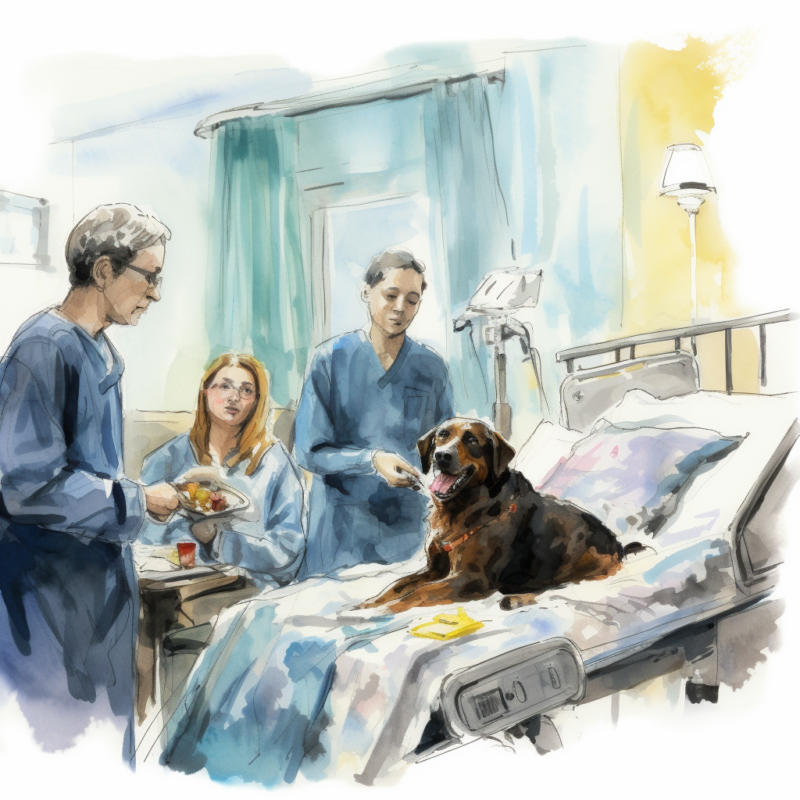Common Infectious Diseases in Dogs: Top 10 Infections to Know
What is it?
How is it Treated?
Breed Predispositions
Bulldogs Shar Peis German Shepherds Cavalier King Charles Spaniels
Introduction
Over the past few days, Mark had observed that his usually energetic and playful Labrador Retriever, Buddy, had become increasingly lethargic and had lost interest in eating. Concerned about his furry friend’s well-being, Mark decided it was time to visit the veterinarian. After a detailed examination and a series of tests, the vet informed Mark that Buddy had contracted an infectious disease. Mark was taken aback by the diagnosis, as he had always been diligent about Buddy’s vaccinations and overall health.
Dogs are very susceptible to certain types of infections. The most common ones include canine distemper, parvovirus, coronavirus, and leptospirosis. These viruses can spread rapidly among dogs, causing severe illness or death.
It’s essential to understand the causes, symptoms, and how to prevent each common disease so that you can recognize them early and seek treatment immediately. For example, the following are some of the most common infectious diseases your dog might have:
1. Canine Parvovirus (“parvo”)
Canine parvovirus (CPV) is a highly contagious viral infection that affects dogs, particularly puppies and unvaccinated dogs. It belongs to the Parvoviridae family and primarily targets the gastrointestinal tract. The virus can cause severe illness and life-threatening, especially in young or immunocompromised dogs.
CPV is transmitted through direct contact with infected dogs or their feces. It can also be spread indirectly through contaminated objects or environments. The virus is highly resistant and can survive in the environment for months, making it easily transmissible.
Once a dog is infected, the virus attacks rapidly, dividing cells in the intestinal lining, bone marrow, and lymphoid tissues. This leads to severe gastroenteritis, causing symptoms such as vomiting, diarrhea (often bloody), lethargy, loss of appetite, and dehydration. In some cases, CPV can also affect the heart, leading to myocarditis.
Prompt diagnosis and treatment are crucial for managing canine parvovirus infection. Veterinary care typically involves supportive therapy for dehydration, electrolyte imbalance, and secondary bacterial infections. In addition, dogs with parvovirus require strict isolation to prevent the spreading of the infection, and in severe cases, hospitalization may be necessary.
Prevention is key to protecting dogs from CPV. Vaccination is highly effective and typically included in puppies’ core vaccination protocols. In addition, maintaining good hygiene, avoiding contact with infected dogs or their feces, and disinfecting contaminated areas are essential preventative measures.

Canine distemper, a common canine disease, is an extremely contagious viral ailment affecting dogs and other animals. It’s triggered by the canine distemper virus (CDV), a member of the Paramyxoviridae family. This disease of dogs primarily impacts the respiratory, gastrointestinal, and nervous systems of the afflicted animals.
The virus is mainly transmitted through respiratory secretions or feces from infected animals, allowing it to spread between animals. However, it can also propagate through objects contaminated by the virus or via direct contact with infected animals. Puppies and unvaccinated dogs are particularly prone to contracting this disease.
Upon infection, the virus proliferates through the respiratory tract and the lymphatic system, aiming at different organs and tissues. It can precipitate various symptoms, including fever, nasal and ocular discharge, coughing, vomiting, diarrhea, lethargy, and loss of appetite. In severe instances, distemper can also provoke neurological symptoms, such as seizures, tremors, and alterations in behavior, making it a common cause of such symptoms in dogs.
Diagnosing distemper generally involves the consideration of clinical signs, history, and laboratory tests such as blood analyses and viral detection from swabs or tissue samples. Unfortunately, no targeted antiviral treatment for distemper exists, so providing supportive care becomes crucial. This includes managing symptoms, supplying fluids to prevent dehydration, and preventing secondary bacterial infections.
Vaccination is one of the most effective ways to protect your dog from distemper. It is typically included in the core puppy vaccination protocols, much like a vaccine for Lyme disease, another disease affecting animals and people. Distemper is a severe and often fatal disease, so prevention through vaccination and avoiding exposure to infected animals is paramount. In addition, practices like maintaining good hygiene, quarantining infected dogs, and disinfecting areas contaminated by the virus also aid in curbing the spread of this virus.
3. External Parasites
External parasites in dogs are organisms that live on the outer surface of the dog’s body and feed on its blood or skin. These parasites can cause discomfort, irritation, and various health issues for dogs. Common external parasites in dogs include fleas, ticks, lice, mites, and mange.
- Fleas are tiny, wingless insects that infest the dog’s fur, causing itching, scratching, and allergic reactions. They can also transmit diseases and parasites.
- Ticks are arachnids that attach to the dog’s skin and feed on its blood. They can transmit various diseases, such as Lyme disease and Ehrlichiosis.
- Mites are microscopic organisms that can cause various skin conditions in dogs. Examples include ear mites, which infest the dog’s ear canals, and sarcoptic mange mites, which cause mange and intense itching.
- Lice are small insects that infest the dog’s fur, causing itching, scratching, and hair loss. They are most commonly seen in puppies and dogs with weakened immune systems.
External parasites can be prevented and treated through various methods, including regular grooming, flea and tick prevention products, maintaining a clean living environment, and seeking veterinary treatment when necessary. However, it’s important to address external parasite infestations promptly to prevent discomfort, reduce the risk of disease transmission, and maintain the overall health and well-being of the dog.

4. Fungal Infectious Disease
Fungal infectious diseases in dogs are caused by various fungi that can infect the dog’s body and cause various health issues. Fungi are microorganisms that can thrive in different environments and infect different parts of the dog’s body, including the skin, respiratory system, digestive system, and internal organs.
Common fungal infections in dogs include:
- Dermatophytosis (Ringworm): This fungal infection affects dogs’ skin, hair, and nails. It can cause circular patches of hair loss, redness, itching, and crusty lesions.
- Aspergillosis: This is a respiratory infection caused by the Aspergillus fungus. Dogs can inhale the spores, leading to respiratory symptoms such as coughing, difficulty breathing, nasal discharge, and sneezing.
- Blastomycosis: This is a systemic fungal infection caused by the fungus Blastomyces. It commonly affects the lungs but can also spread to other organs. Symptoms may include coughing, difficulty breathing, weight loss, skin lesions, and eye problems.
- Histoplasmosis: This is another systemic fungal infection caused by the fungus Histoplasma. Dogs can contract the infection by inhaling fungal spores. It can affect the lungs, liver, spleen, and other organs. Symptoms may include coughing, weight loss, loss of appetite, and fever.
- Cryptococcosis: This is a fungal infection caused by the Cryptococcus fungus. It primarily affects the respiratory system but can also involve the central nervous system. Symptoms may include nasal discharge, respiratory distress, neurological signs, and eye problems.
Fungal infections in dogs are typically diagnosed through clinical signs, microscopic examination of samples, fungal culture, and other specialized tests. In addition, treatment often involves antifungal medications specific to the type of infection and supportive care to manage symptoms and promote healing. Therefore, it’s important to consult a veterinarian to diagnose and treat fungal infections in dogs.
5. Leptospirosis
Leptospirosis is a bacterial infection that afflicts dogs, other animals, and even humans. This disease is caused by bacteria belonging to the Genus Leptospira. These bacteria, typically present in the urine of infected animals, have a remarkable ability to survive in soil and water for prolonged periods. As a result, dogs are susceptible to infection through contact with contaminated water, soil or through interaction with infected animals, including rodents, wild animals, and wildlife.
The clinical presentations of leptospirosis can vary, ranging from mild to severe. In certain instances, dogs may not exhibit any discernible symptoms, while in others, the disease could progress rapidly, culminating in serious illness. Common indications of leptospirosis in dogs include:
- fever
- lethargy
- decreased appetite
- vomiting, diarrhea
- abdominal pain
- muscle pain
- jaundice (yellowing of the skin and eyes)
Leptospirosis also qualifies as a zoonotic disease, signifying that it can be transmitted from animals to humans. Therefore, exercising caution is vital when interacting with an infected dog or when contacting its bodily fluids, including contact with animal feces.
The diagnosis of leptospirosis is usually determined through a mix of clinical signs, blood tests, and specific laboratory tests aimed at detecting the presence of Leptospira bacteria or antibodies in the dog’s blood or urine. Treatment typically incorporates antibiotics to exterminate the bacteria and supportive care to manage symptoms and avoid complications.
Prevention of leptospirosis includes vaccination, avoiding interaction with potentially contaminated environments or animals, and adhering to good hygiene practices, such as donning protective gloves when handling potentially infected animals or their fluids. Further, a consultation with a veterinarian is vital for diagnosing, treating, and preventing leptospirosis in dogs. Finally, it’s essential to remember that dogs carry many diseases, and this virus is very contagious, underscoring the importance of preventative measures.
6. Kennel Cough
Kennel cough, or canine infectious tracheobronchitis, is a highly contagious respiratory infection many dogs can contract. Viruses and bacteria, including canine parainfluenza, canine adenovirus, and Bordetella bronchiseptica, typically cause this illness. Notably, the disease occurs when these pathogens are present and easily spread in areas where dogs are nearby, such as kennels, dog parks, or grooming facilities.
The cardinal symptom of kennel cough is a persistent, dry, hacking cough, often forceful and suggestive of a dog attempting to clear its throat. Dogs may also display symptoms including sneezing, nasal discharge, a mild fever, loss of appetite, and lethargy. The cough may sometimes worsen, leading to discomfort and difficulty breathing.
Despite being a relatively new disease identified in the world of canine health, kennel cough is usually categorized as a self-limiting disease. This is because it naturally resolves on its own within a few weeks. Nonetheless, it can advance to more acute respiratory infections or pneumonia in certain instances, particularly in puppies or dogs with compromised immune systems. Thus, attentive observation of the dog’s symptoms and timely veterinary care are paramount.
The therapeutic approach for kennel cough chiefly involves supportive care to mitigate symptoms. This may involve administering cough suppressants or bronchodilators to facilitate easier breathing. Also, if a bacterial infection is suspected, antibiotics may be prescribed to prevent secondary bacterial infections. Rest and isolation from other dogs are also vital to prevent the disease from spreading further. Knowing that most dogs will recover is reassuring, but immediate veterinary attention is needed when disseminated disease occurs.
7. Rabies
Rabies is a lethal viral disease impacting the nervous systems of mammals, including dogs, which can lead to dire neurological symptoms. The rabies virus, responsible for the disease, is typically transmitted via the bite or scratch from an affected dog or other infected animals. This disease is caused by the virus infiltrating the brain and spinal cord.
In its initial stages, rabies in dogs may present indistinct symptoms. These can encompass behavioral shifts such as heightened aggression or withdrawal, excessive salivation, and challenges in swallowing. As the disease advances, more severe symptoms manifest in the affected dogs. These include muscular weakness, paralysis, confusion, seizures, and eventual coma or death. Rabies is a fatal disease once its clinical signs surface; currently, no cure exists.
Since rabies is a zoonotic infection capable of transmission to humans and other animals, prevention is paramount. Rabies vaccination is the most effective measure to safeguard dogs against this disease. It’s usually administered in a series starting at a young age, followed by regular booster shots. Dog rabies vaccination is a legal requirement in numerous jurisdictions, including the United States.
In regions where rabies is prevalent, maintaining close supervision of dogs, including female dogs who might be more vulnerable due to pregnancy or nursing, is critical to prevent contact with wild animals like bats, raccoons, skunks, and foxes, which are common virus carriers. This precaution is especially important during events where many dogs, like a dog show, are gathered. If a potentially rabid animal bites a dog, immediate veterinary care is necessary, and the incident must be reported to the local animal control or public health authorities. Timely and appropriate management can help curtail the spread of rabies to humans, other animals, and even healthy dogs, thus mitigating the overall risk of infection.
8. Canine Parainfluenza
Canine parainfluenza is a highly contagious respiratory virus that affects dogs. It is one of the pathogens commonly associated with kennel cough, a respiratory infection characterized by a harsh, dry cough. Canine influenza is caused by the parainfluenza virus, which primarily affects the respiratory system of dogs.
The virus is spread through respiratory secretions, such as coughing or sneezing, from infected dogs. It can also be transmitted indirectly through contaminated surfaces or objects. Puppies, elderly dogs, and dogs with weakened immune systems are particularly susceptible to infection.
The symptoms of canine parainfluenza include a persistent, dry cough, nasal discharge, sneezing, and mild respiratory distress. The infection may sometimes progress to more severe respiratory symptoms, such as pneumonia. It is important to note that canine parainfluenza can be easily mistaken for other respiratory infections, so proper diagnosis by a veterinarian is essential.
Vaccination against CPIV is recommended for puppies younger than eight weeks old. Vaccinated puppies older than eight weeks old should receive booster vaccinations every three months. Booster vaccines are available commercially.
9. Canine Coronavirus
Canine coronavirus is a highly contagious viral infection that primarily affects the gastrointestinal system of dogs. It is caused by the canine coronavirus (CCoV) and is different from the coronavirus strain that causes COVID-19 in humans.
Canine coronavirus is spread through contact with infected feces, contaminated surfaces, or oral exposure to infected material. Puppies and dogs with weakened immune systems are more susceptible to the virus. The virus primarily affects the small intestine, leading to inflammation and damage to the intestinal lining.
The symptoms of canine coronavirus infection can vary but commonly include diarrhea, vomiting, loss of appetite, lethargy, and dehydration. In severe cases, it can lead to more serious gastrointestinal issues. It is important to note that canine coronavirus infection can be easily mistaken for other gastrointestinal illnesses, so proper diagnosis by a veterinarian is essential.
Preventing canine coronavirus involves good hygiene practices, such as proper sanitation of living areas, regular cleaning of food and water bowls, and prompt removal and disposal of feces. Vaccination against canine coronavirus is available in some regions but is not considered a core vaccine and is generally recommended based on the dog’s risk of exposure. Therefore, consulting with a veterinarian is crucial to determine the appropriate preventive measures for each dog.
10. Canine Hepatitis
Infectious canine hepatitis (ICH), also referred to as canine hepatitis, is a prevalent viral ailment primarily affecting the livers and other organs of domestic dogs. The disease is instigated by canine adenovirus type 1 (CAV-1), and its transmission is highly efficient, spreading through contact with infected dogs’ urine, feces, saliva, or nasal secretions.
The signs of infectious canine hepatitis in dogs can fluctuate, depending on the intensity of the infection. Light cases might present symptoms such as fever, lethargy, diminished appetite, and coughing. More severe cases can result in jaundice (yellowing of the eyes and mucous membranes), abdominal discomfort, vomiting, diarrhea, and possibly life-threatening complications like liver failure and clotting disorders. This inflammatory disease is usually more severe in young dogs, while older dogs may have milder symptoms or be asymptomatic carriers.
There exists a vaccination to avert canine hepatitis, and it’s often incorporated into the core vaccination regimen for dogs. In addition, vaccination aids in fostering immunity against the virus, diminishing the threat and harshness of the disease. Hence, dog owners must adhere to the suggested vaccination timeline and ensure their dog’s vaccinations remain current.
If you suspect that your dog might have canine hepatitis, immediate veterinary attention is vital. Treatment usually involves supportive care tailored to manage symptoms and ward off complications. This care may encompass intravenous fluids, medications to bolster liver function, and other supportive therapies suited to the specific needs of the individual dog. Moreover, early detection of this common form in dogs, combined with preventive measures like vaccination and proper hygiene practices, can significantly aid in protecting dogs from canine hepatitis. Therefore, the infection is usually manageable if caught early and treated appropriately.
Frequently Asked Questions
Disclaimer: The information provided on this veterinary website is intended for general educational purposes only and should not be considered as a substitute for professional veterinary advice, diagnosis, or treatment. Always consult a licensed veterinarian for any concerns or questions regarding the health and well-being of your pet. This website does not claim to cover every possible situation or provide exhaustive knowledge on the subjects presented. The owners and contributors of this website are not responsible for any harm or loss that may result from the use or misuse of the information provided herein.







